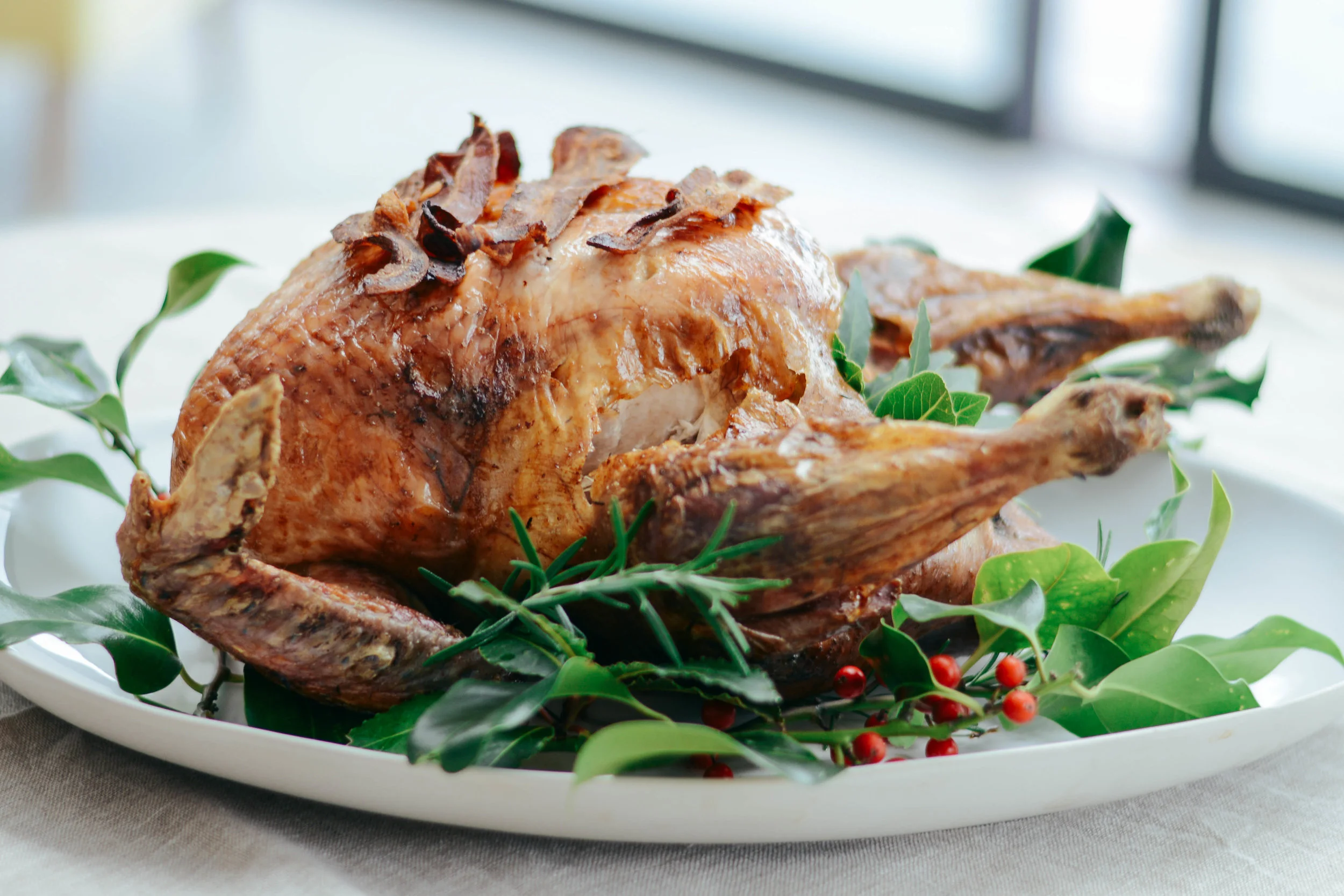Traditional roast turkey with pork, sage and onion stuffing
Weʼve tried and tasted a lot of turkey recipes over the years, but we still believe that Delia Smith's traditional roast turkey with pork, sage and onion stuffing recipe is our all time favourite.
We have more delicious side dish recipes on our blog: www.harrystreetmeats.co.uk/christmas
View the recipes here: www.deliaonline.com/ingredient/turkey
INGREDIENTS
1 turkey, about 14 lb (6.3 kg) oven-ready 6 oz (175 g) softened butter
8 oz (225 g) very fat streaky bacon
salt and freshly milled black pepper
For the pork, sage and onion stuffing:
2 lb (900 g) good-quality pork sausage meat or finely minced pure pork
1 heaped dessertspoon dried sage
1 large onion, grated or very finely chopped 4 heaped tablespoons white breadcrumbs
1 egg, beaten (optional)
salt and freshly milled black pepper
For the gravy
about 2 level tablespoons plain flour
1 quantity Turkey Giblet Stock
CHRISTMAS EVE
Before you start, please bear in mind that it is important to take the turkey out of the fridge last thing on Christmas Eve to allow it to come to room temperature so that it heats up immediately you put it in the oven.
The same applies to the stuffing (you can make this on Christmas Eve, ahead of time), and you also need to remove the 6 oz (175 g) of butter to soften ready for the morning.
To make the stuffing, combine the breadcrumbs with the onion and sage in a large mixing bowl, then stir in a little boiling water and mix thoroughly. Next work the sausage meat or minced pork and egg, if using, into this mixture and season with salt and pepper. Leave the stuffing covered in a cool place – but not in the fridge, as it shouldn't be too cold when you come to stuff the turkey.
ON CHRISTMAS DAY
On the morning of cooking, pre-heat the oven to gas mark 7, 425°F (220°C) then stuff the turkey.
Loosen the skin with your hands and pack the stuffing into the neck end, pushing it up between the flesh and the skin towards the breast (though not too tightly because it will expand during the cooking). Press it in gently to make a nice rounded end, then tuck the neck flap under the bird's back and secure with a small skewer.
Don't expect to get all the stuffing in this end – put the rest into the body cavity.
Now arrange two large sheets of foil across your baking tin – one of them widthways, the other lengthways (no need to butter them). Lay the turkey on its back in the centre, then rub it generously all over with the butter, making sure the thighbones are particularly well covered.
Next season the bird all over with salt and pepper, and lay the bacon over the breast with the rashers overlapping each other. I always put some over the legs as well. The idea now is to wrap the turkey in the foil. The parcel must be firmly sealed but roomy enough inside to provide an air space around most of the upper part of the turkey. So bring one piece of foil up and fold both ends over to make a pleat along the length of the breastbone – but well above the breast.
Then bring the other piece up at both ends, and crimp and fold to make a neat parcel. Place the roasting tin on a low shelf in the oven and cook at the initial high temperature for 40 minutes.
After that, lower the heat to gas mark 3, 325°F (170°C) and cook for a further 3 hours for a 12 lb bird (around 5.5 kg), or 31⁄2 hours for a 14 lb bird (around 6.3 kg).
Then tear the foil away from the top and sides of the bird and remove the bacon slices to allow the skin to brown and crisp. The bacon rashers can be placed on a heat-proof plate and put back in the oven to finish cooking till all the fat has melted and there are just very crisp bits left. (I like to serve these crunchy bits with the turkey as well as bacon rolls.)
Turn the heat up to gas mark 6, 400°F (200°C) and cook the turkey for a further 30 minutes.
The turkey will need frequent basting during this time, so the whole operation will probably take nearer 40-45 minutes. To test if the bird is cooked, pierce the thickest part of the leg with a thin skewer: the juices running out of it should be golden and clear. And the same applies to any part of the bird tested – there should be no trace of pinkness in the juices. You can also give the leg a little tug, to make sure there is some give in it.
AND FINALLY...
Then remove it from the roasting tin (using a carving fork and fish slice) and transfer it to a warm carving dish. If you can engage someone's help while lifting it, it's a good idea to tip the turkey to let the excess juice run out. Leave the turkey in a warmish place for 30-60 minutes to 'relax' before carving: provided it's not in a draught it will stay hot for that length of time, and it will give you a chance to turn the heat up in the oven to crisp the roast potatoes.
GRAVY
Meanwhile, to make the gravy, tip all the fat and juices out of the foil into the roasting tin. Spoon off all the fat from the juice in a corner of the tin, then work the flour into the remaining juices over a low heat.
Now, using a balloon whisk, whisk in the giblet stock, bit by bit, until you have a smooth gravy. Let it bubble and reduce a little to concentrate the flavour, and taste and season with salt and pepper. Then pour it into a jug and keep warm.






